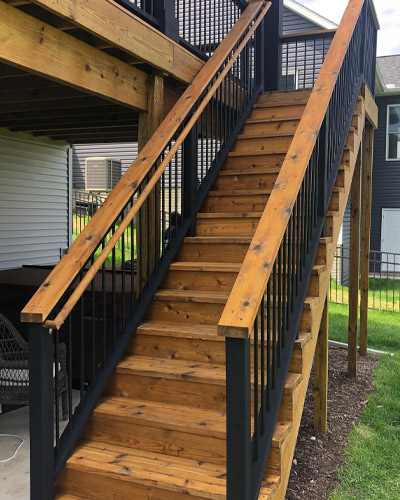Deck Staining 101: Every Little Thing You Required to Know for a Do It Yourself Project
From preparing the deck surface to choosing the right kind of tarnish and understanding the application techniques, each step plays a crucial duty in accomplishing an expert coating. Join us as we untangle the essential standards and insider suggestions for grasping the art of deck staining, ensuring an effective DIY task that will leave your deck looking flawless.
Importance of Deck Staining
Deck staining is an essential maintenance job that maintains the longevity and look of outside wood frameworks. Wood decks are constantly exposed to extreme elements such as sunshine, snow, foot, and rainfall traffic, every one of which can result in tear and wear with time. By using a layer of stain to the deck's surface, you create a safety barrier that assists protect against moisture penetration, UV damage, and decaying of the timber. This not only expands the life expectancy of the deck yet likewise preserves its visual appeal.
Furthermore, deck staining improves the all-natural charm of the wood by highlighting its grain and appearance. It offers a possibility to customize the appearance of the deck by picking from a selection of discolor surfaces and colors. Whether you like a transparent discolor that showcases the wood's natural color or a solid stain that includes a pop of color, the right tarnish can raise the general aesthetic of your exterior home. Basically, regular deck staining is a straightforward yet reliable method to guarantee your deck remains structurally audio and aesthetically pleasing for many years to find.
Deck Prep Work Tips

After cleansing and repairing, sanding the deck is essential to smooth out harsh surface areas and open up the wood's pores to better take in the tarnish. As soon as the deck is clean, dry, and smooth, shield any nearby plants, furniture, or surfaces with a decrease cloth before applying the deck stain.
Picking the Right Discoloration
Choosing the proper stain for your deck is a critical decision that directly impacts both its appearance and resilience. When selecting the ideal discolor, there are numerous elements to take into consideration to make sure an effective do it yourself task.
To start with, you require to decide in between transparent, semi-transparent, and strong spots. Clear spots permit the all-natural grain of the wood to show with however provide minimal protection against UV rays and moisture. Semi-transparent spots supply a concession between shade and protection, while strong stains supply one of the most defense however cover the wood grain.
Next, think about the kind of timber your deck is made of, as various stains work much better with particular wood types. For example, redwood and cedar decks typically look ideal with a clear or semi-transparent tarnish to highlight their natural appeal. Pressure-treated timber could gain from a solid stain to conceal flaws.
Lastly, aspect in the climate in your location. Decide for a stain with UV protection and resistance to extreme weather conditions if you experience extreme winter seasons or extreme sunlight. By thoroughly taking into consideration these elements, you can pick a tarnish that boosts your deck's visual appeals and long life.

Using Discoloration Appropriately
When thinking about the application of tarnish to your deck, it is necessary to pay very close attention to the specific qualities of the stain chosen and how it communicates with the type of wood and environmental problems previously mulled over. Prior to beginning the discoloration process, make sure that the deck surface is tidy, dry, and devoid of any previous finishings or particles. It is recommended to check the chosen stain on a small unnoticeable location of the deck to make certain compatibility and achieve the desired shade and finish.
Use the tarnish along the length of the deck boards to avoid irregular pooling - fence staining near me. It is important to work with the timber grain to improve the natural appeal of the deck and allow for better infiltration of the tarnish.
Maintenance and Treatment Tips

An additional critical element of deck maintenance is securing it from the components. Take into consideration applying a waterproof sealant every few years to shield the timber from wetness damage. Furthermore, resolving any type of mold or mold quickly is necessary to prevent them from causing architectural injury to your deck. Consistently trimming neighboring vegetation can additionally stop leaves and go branches from collecting on your deck and causing possible damages.
Conclusion
Finally, deck discoloration is a vital action in keeping the look and longevity of your outdoor area. By appropriately preparing the deck, selecting the appropriate discolor, using it appropriately, and complying with maintenance tips, you can guarantee a durable and beautiful surface that will certainly last for years to come. Remember to regularly care and check for your tarnished deck to maintain it looking its ideal.
Join us as we untangle the crucial guidelines and expert pointers for mastering the art of deck discoloration, ensuring an effective DIY task that will leave your deck looking impeccable. - deck staining companies near me
In essence, regular deck staining is an easy yet efficient means to guarantee your deck continues to be structurally audio and visually fence builders near me pleasing for years to come.
Once the deck is tidy, dry, and smooth, shield any type of basics nearby plants, furnishings, or surfaces with a drop towel before applying the deck stain.Next, consider the kind of timber your deck is made of, as different stains function better with particular wood varieties.When taking into consideration the application of stain to your deck, it is vital to pay close interest to the certain characteristics of the discolor chosen and just how it engages with the kind of timber and ecological conditions formerly mulled over.